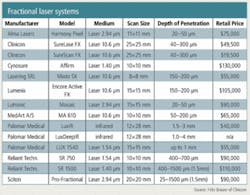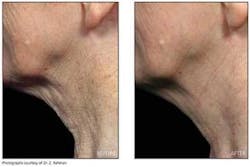DERMATOLOGY LASERS: ‘Battle of the fractionals’ heats up in dermatology
Three years ago, when Reliant Technologies (Mountain View, CA) introduced the first fractional laser skin rejuvenation system, the initial reaction by many was “do we really need another laser in this market?” But what Reliant brought to the market at that time was, in fact, a revolutionary technique that has garnered the company healthy sales and spurred a number of competitors to follow suit. Today there are at least 10 companies marketing fractional laser systems to dermatologists and plastic surgeons, offering a number of different wavelengths, depth capabilities, and price points (see table).
Reliant’s flagship Fraxel laser system, the Fraxel re:store, utilizes a 30 W 1550 nm erbium-fiber laser (from IPG Photonics) that works in conjunction with Reliant’s proprietary fractional scanning system to achieve precise resurfacing and remodeling of the skin while minimizing collateral thermal damage (for a more technical explanation of the technology and how it works, see www.reliant-tech.com/fraxel-laser-resurfacing.cfm). Reliant subsequently launched a 1410 nm model, the Fraxel re:fine, followed last July by a 1.60 µm CO2 version, the Fraxel re:pair, that is designed to treat fine lines, pigmentation, and elasticity (including in the neck and upper chest) with a combination of conventional CO2 resurfacing and nonablative fractional photothermolysis.
“At the American Academy of Dermatology meeting (Feb. 1–5; San Antonio, TX), eight companies were showing fractional lasers (CO2 and erbium),” says Dr. Christopher Zachary, chair of the Department of Dermatology, University of California at Irvine, who has worked with all of the Reliant systems as well as several other fractional laser systems. “So either it means the technology works or there is a perception that it works. But with the development of the Fraxel re:pair system, we are going to see something remarkable. This device is going to sell itself because it produces significant tissue tightening, wrinkle reduction, and textural improvement both on and off the face, and you see results after one treatment (see figure).”
The downside, however, is that because this is an ablative treatment patients have longer recovery times compared to the popular nonablative erbium-laser “lunchtime” treatments of the last few years. At the same time, fewer treatments are needed compared to nonablative fractional systems, which means the cost is ultimately about the same. With the Fraxel re:pair system, a typical treatment session is $3000 to $5000; with the Fraxel re:store each session is $1500, but four to six treatments are needed.
“The big advantage of the Reliant system is the power and the speed of the scanning device,” Zachary says. “You can lay down 2000 pulses/s, and no other system can do that. So right now, Reliant has an advantage not only because of the production and reliability and smoke evacuator, but the speed of treating a face. I can treat a face in 20 minutes, and I can treat deep furrows, brown spots, blood vessels, acne scarring, and darker skin types.”
Histologic proof
Reliant is not the only company making this claim, but it clearly has a leg up in terms of a well-documented success story—and not just in terms of product sales. The company not only develops and manufactures its laser systems at its Mountain View facility but conducts its own histology studies and houses an actual clinic on-site that treats patients on a daily basis. Reliant believes that, in addition to its technology and proprietary approach, one of the things that sets it apart is its emphasis on providing long-term study results to physicians and patients so they can see for themselves what its various technologies are capable of.1,2
“We want to let the patients choose and let the doctors develop the right treatment for their patients,” says Michael Hromadik, public relations manager at Reliant. “There are those who just want a little tone and texture, and previously only the intense pulsed light (IPL) devices were available for those patients. While there is little down time following the IPL procedures, there are also little results in terms of texture, and patients like the texture of their skin after fraxel treatments. That’s why we developed the Fraxel re:fine, which uses the same complex fraxel technology as the re:store but you don’t get the same kind of hyperpigmentation or burns that can happen with the IPLs.”
Likewise, Reliant developed the Fraxel re:pair system to address the needs of another key demographic, he adds: people with wrinkles and skin laxity such as sagging skin around the jowls, face, mouth, and eyes who are not really candidates for a facelift but who want to see improvement.
“When a patient goes into the doctor, they need to break it down into whether they want nonablative or ablative treatment,” Hromadik says. “The market is telling us that people want real improvement, not smoke and mirrors.”
–KK
REFERENCES
1. R. Geronemus, Lasers in Surgery and Medicine 38, 169 (2006).
2. V.P. Bedi et al., Lasers in Surgery and Medicine 39, 145 (2007).

